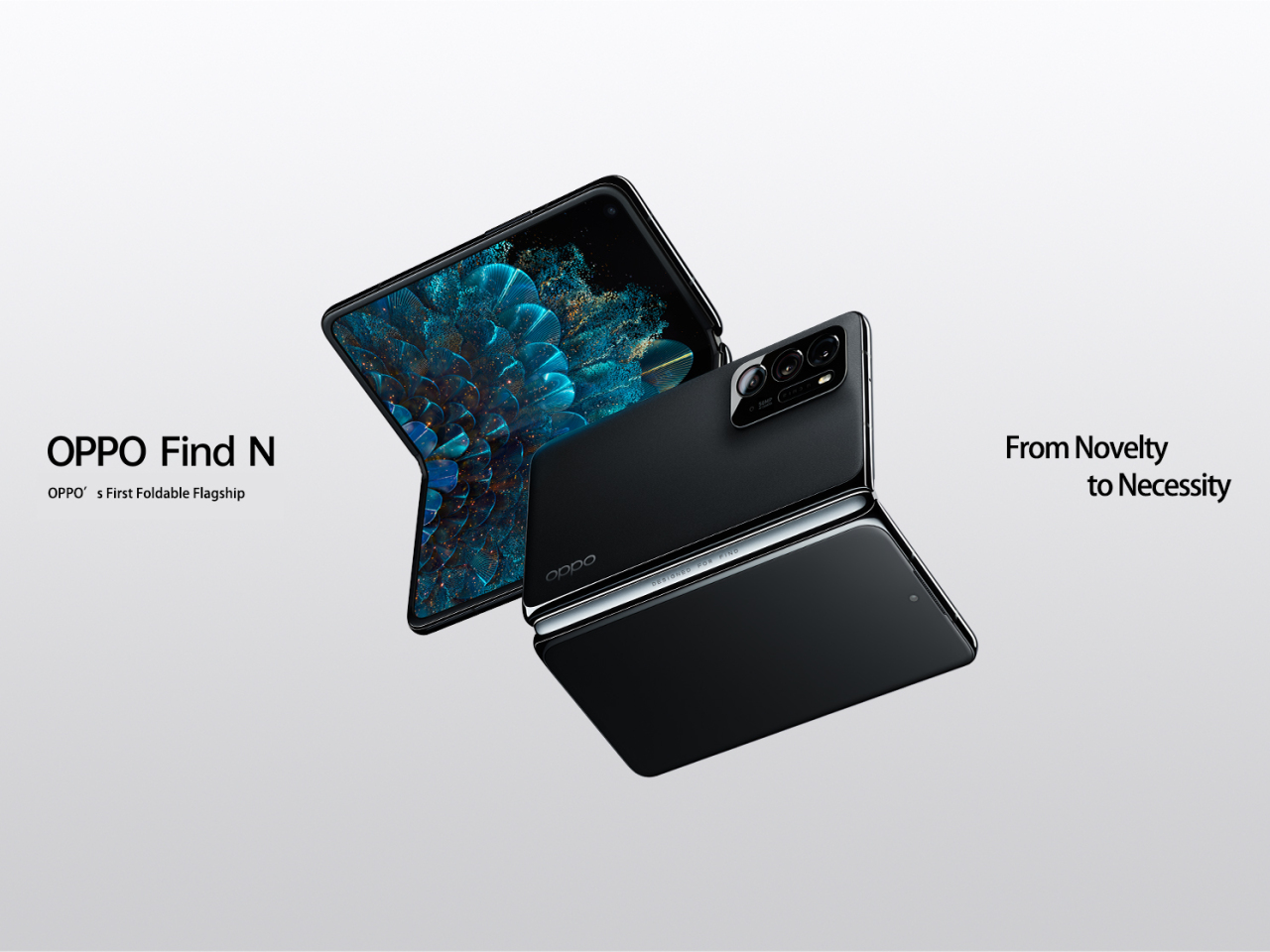
A promotional image of Oppo‘s Find N (Guangdong Oppo Mobile Telecommunications)
Chinese smartphone brand Oppo’s Find N, the first flagship foldable phone unveiled the previous week, suggests how premium electronic gadget fans have been thirsty for a seamless end-user experience.
With Find N, Oppo is looking to prove that consumers can find a foldable phone attractive with creaseless inner screens. But it is unlikely that Oppo’s release would directly challenge Samsung’s leadership in the market, especially since it already has a similar foldable phone, the Galaxy Z Fold.
The technology Oppo materialized in its new clamshell phone does not require the delicate technology Samsung uses. Although it may put Samsung under pressure to deal with the crease in the next Galaxy Z Fold lineup, according to tech experts.
Find N, to be released in China on Thursday, flaunts a 7.1-inch inner screen whose crease is “up to 80 percent less noticeable compared with other devices,” Oppo said, citing Germany’s Technical Inspection Association.
The feature, “at least for eight days of my using it, pretty much means you can’t see it when the screen is on,” said Arun Maini, who runs the technological review YouTube channel Mrwhosetheboss, in his latest Find N review.
The handset is also cheaper. It is priced at a third of the cost of Samsung’s flagship Galaxy Z Fold 3 that was unveiled in August.
Its form factor that enabled these was born despite Samsung’s upper edge over Oppo in screen technology.
Experts pointed to Samsung’s technological leadership in terms of the radius of its curved displays, which means they can be more tightly folded than Oppo’s flagship product.
Since 2020, the South Korean electronics giant has used the foldable organic light-emitting diode panels with the smallest 1.4-millimeter radius of curvature in the world.
Oppo Find N’s crease-reducing hinge, which folds inward in the shape of a water drop, was rather a by-product of “coping with its tech limitations” in reducing the folding radius, said Yi Choong-hoon, chief analyst at Seoul-based tech consultancy UBI Research. Find N’s folding radius is at around 2 millimeters.
“It is not a matter of which technology is superior,” Yi told The Korea Herald. “It is about the difference in the philosophies and concepts behind each company.”
Moon Dae-gyu, a material science and engineering professor at Soonchunhyang University, said: “The larger the folding radius is, the less stress and less crease a display panel can have.”
In theory, a loose folding curve increases the folding gap, meaning a phone’s hinge protrudes more. Oppo’s Find N appears to have challenged this idea.
The handset, only available in Chinese market, is said to be folding flat and measures 15.9 millimeters in thickness.
This contrasts with Samsung’s Galaxy Z Fold 3, whose hinge on the spine protrudes. As a result, Samsung’s is thinner along one edge, but the phone does not lie flat and measures between 14.4-16 millimeters at the hinge.
While both are still thicker -- when folded -- than a stack of two regular smartphones, foldable phone makers will likely be in a heated race to make them thinner.
The foldables still have room to get thinner by adjusting the hinge or reducing the thickness of the glass, Moon of Soonchunhyang University said. He added that Samsung, with a smaller radius of display curve, may have a chance of “choosing to make foldables slimmer.”
Meanwhile, doubts still persist over the durability of both Oppo’s Find N and Samsung’s Galaxy Z Fold 3.
In terms of dust and water resistance, Oppo’s Find N has yet to reveal its Ingress Protection rating (IP rating) for either dust or water resistance. Samsung’s Galaxy Z Fold 3 was rated IPX8, meaning its dust resistance level was not tested but was waterproof enough to withstand submersion up to 1.5 meters underwater for up to 30 minutes.
The foldable gadgets’ hefty price tags, visible creases in the screens, bulkiness and low durability compared to other smartphones have drawn criticism, and to make things worse, the competition is growing with existing players’ new releases and tech powerhouses’ entry into the market.
In 2022, Xiaomi is expected to release its second-generation foldable phones, and Vivo is also considering making a debut in the foldable smartphone market. Apple’s foldable launch is forecast to come as soon as 2023.
In August, research firm Counterpoint Research predicted foldable smartphone shipments to grow 10 times by 2023, and forecast Samsung to take about 75 percent of the market share.
Oppo’s Find N release will “contribute to enriching the ecosystem of foldable smartphones,” although the concept is still widely considered novel, said Noh Geun-chang, an analyst at Hyundai Motor Securities.





![[KH Explains] How should Korea adjust its trade defenses against Chinese EVs?](http://res.heraldm.com/phpwas/restmb_idxmake.php?idx=645&simg=/content/image/2024/04/15/20240415050562_0.jpg&u=20240415144419)
